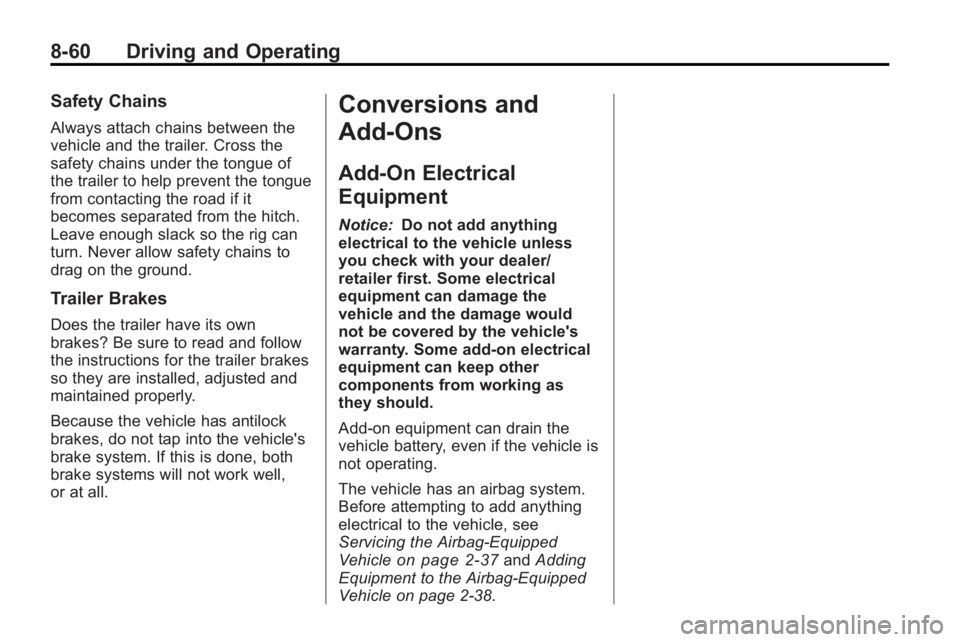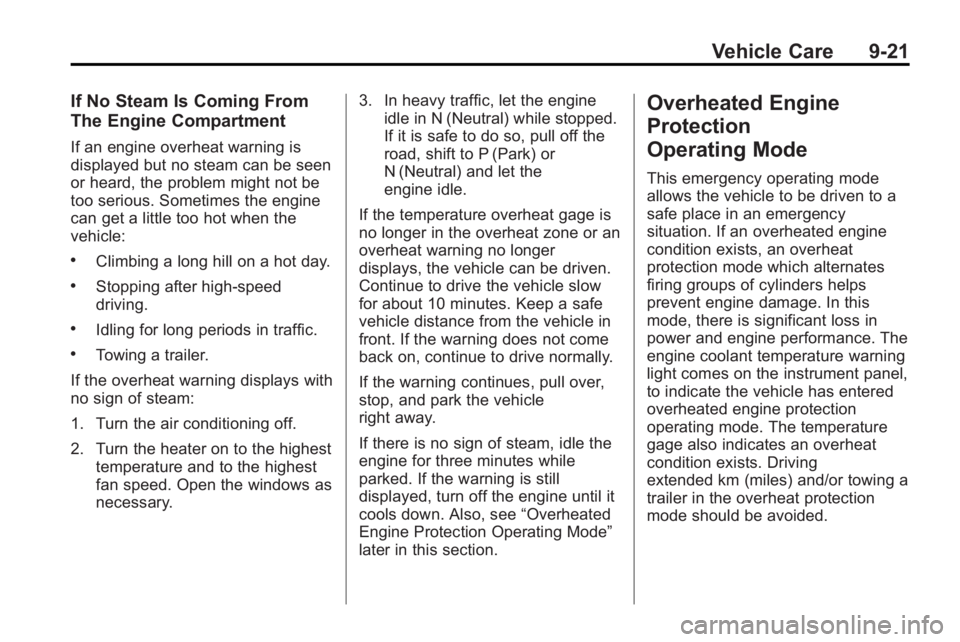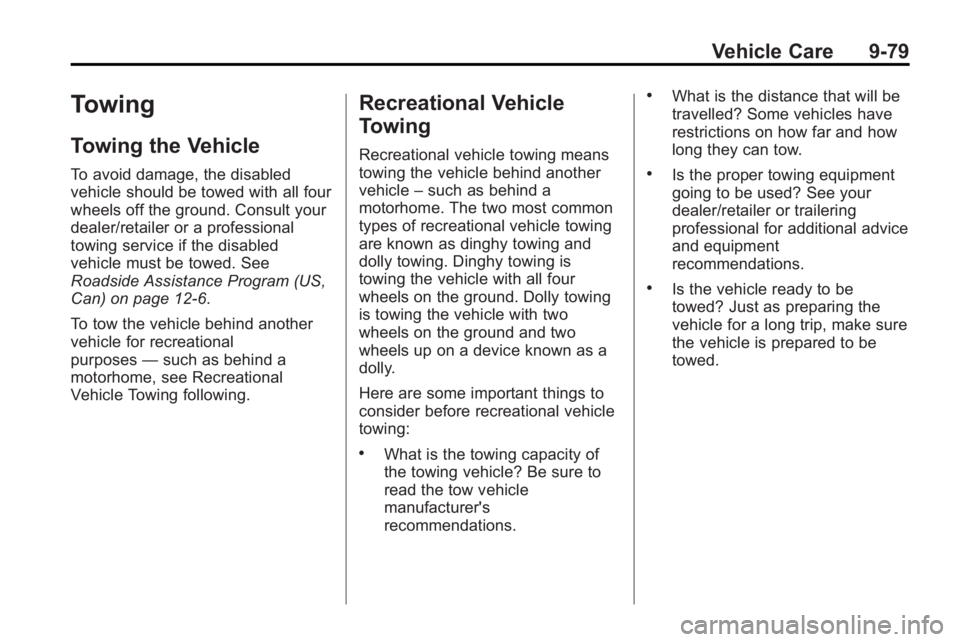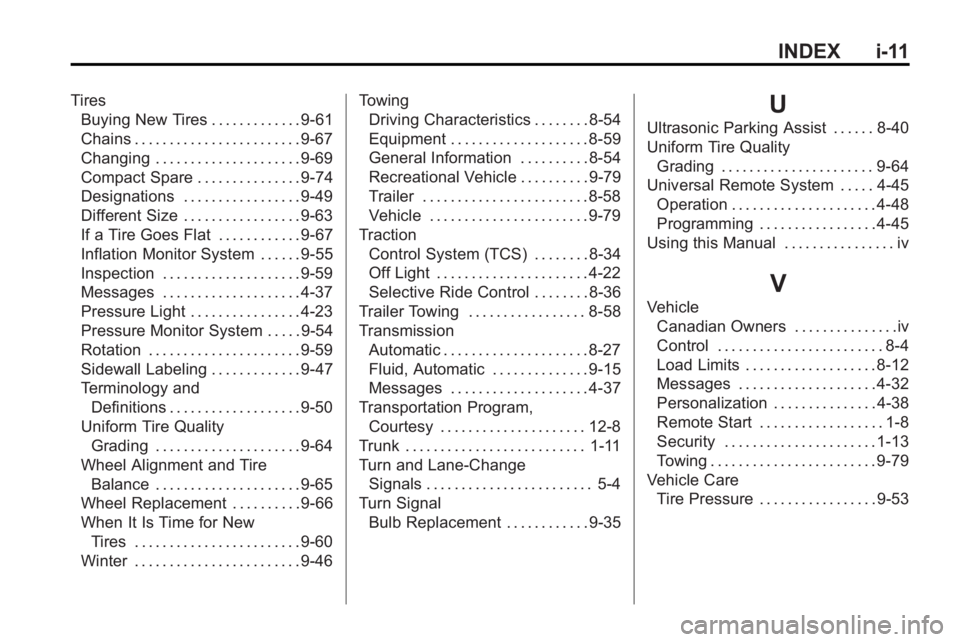2010 BUICK LACROSSE trailer
[x] Cancel search: trailerPage 282 of 414

8-60 Driving and Operating
Safety Chains
Always attach chains between the
vehicle and the trailer. Cross the
safety chains under the tongue of
the trailer to help prevent the tongue
from contacting the road if it
becomes separated from the hitch.
Leave enough slack so the rig can
turn. Never allow safety chains to
drag on the ground.
Trailer Brakes
Does the trailer have its own
brakes? Be sure to read and follow
the instructions for the trailer brakes
so they are installed, adjusted and
maintained properly.
Because the vehicle has antilock
brakes, do not tap into the vehicle's
brake system. If this is done, both
brake systems will not work well,
or at all.
Conversions and
Add-Ons
Add-On Electrical
Equipment
Notice:Do not add anything
electrical to the vehicle unless
you check with your dealer/
retailer first. Some electrical
equipment can damage the
vehicle and the damage would
not be covered by the vehicle's
warranty. Some add-on electrical
equipment can keep other
components from working as
they should.
Add-on equipment can drain the
vehicle battery, even if the vehicle is
not operating.
The vehicle has an airbag system.
Before attempting to add anything
electrical to the vehicle, see
Servicing the Airbag-Equipped
Vehicle
on page 2‑37and Adding
Equipment to the Airbag-Equipped
Vehicle on page 2‑38.
Page 303 of 414

Vehicle Care 9-21
If No Steam Is Coming From
The Engine Compartment
If an engine overheat warning is
displayed but no steam can be seen
or heard, the problem might not be
too serious. Sometimes the engine
can get a little too hot when the
vehicle:
.Climbing a long hill on a hot day.
.Stopping after high-speed
driving.
.Idling for long periods in traffic.
.Towing a trailer.
If the overheat warning displays with
no sign of steam:
1. Turn the air conditioning off.
2. Turn the heater on to the highest temperature and to the highest
fan speed. Open the windows as
necessary. 3. In heavy traffic, let the engine
idle in N (Neutral) while stopped.
If it is safe to do so, pull off the
road, shift to P (Park) or
N (Neutral) and let the
engine idle.
If the temperature overheat gage is
no longer in the overheat zone or an
overheat warning no longer
displays, the vehicle can be driven.
Continue to drive the vehicle slow
for about 10 minutes. Keep a safe
vehicle distance from the vehicle in
front. If the warning does not come
back on, continue to drive normally.
If the warning continues, pull over,
stop, and park the vehicle
right away.
If there is no sign of steam, idle the
engine for three minutes while
parked. If the warning is still
displayed, turn off the engine until it
cools down. Also, see “Overheated
Engine Protection Operating Mode”
later in this section.
Overheated Engine
Protection
Operating Mode
This emergency operating mode
allows the vehicle to be driven to a
safe place in an emergency
situation. If an overheated engine
condition exists, an overheat
protection mode which alternates
firing groups of cylinders helps
prevent engine damage. In this
mode, there is significant loss in
power and engine performance. The
engine coolant temperature warning
light comes on the instrument panel,
to indicate the vehicle has entered
overheated engine protection
operating mode. The temperature
gage also indicates an overheat
condition exists. Driving
extended km (miles) and/or towing a
trailer in the overheat protection
mode should be avoided.
Page 361 of 414

Vehicle Care 9-79
Towing
Towing the Vehicle
To avoid damage, the disabled
vehicle should be towed with all four
wheels off the ground. Consult your
dealer/retailer or a professional
towing service if the disabled
vehicle must be towed. See
Roadside Assistance Program (US,
Can) on page 12‑6.
To tow the vehicle behind another
vehicle for recreational
purposes—such as behind a
motorhome, see Recreational
Vehicle Towing following.
Recreational Vehicle
Towing
Recreational vehicle towing means
towing the vehicle behind another
vehicle –such as behind a
motorhome. The two most common
types of recreational vehicle towing
are known as dinghy towing and
dolly towing. Dinghy towing is
towing the vehicle with all four
wheels on the ground. Dolly towing
is towing the vehicle with two
wheels on the ground and two
wheels up on a device known as a
dolly.
Here are some important things to
consider before recreational vehicle
towing:
.What is the towing capacity of
the towing vehicle? Be sure to
read the tow vehicle
manufacturer's
recommendations.
.What is the distance that will be
travelled? Some vehicles have
restrictions on how far and how
long they can tow.
.Is the proper towing equipment
going to be used? See your
dealer/retailer or trailering
professional for additional advice
and equipment
recommendations.
.Is the vehicle ready to be
towed? Just as preparing the
vehicle for a long trip, make sure
the vehicle is prepared to be
towed.
Page 375 of 414

Service and Maintenance 10-5
.SeeIgnition Transmission Lock
Check on page 9‑28.
.See Park Brake and P (Park)
Mechanism Checkon
page 9‑28.
.Engine cooling system and
pressure cap pressure check.
Radiator and air conditioning
condenser outside cleaning.
See Cooling System
on
page 9‑17.
.Exhaust system and nearby heat
shields inspection for loose or
damaged components.
.Accelerator pedal check for
damage, high effort, or binding.
Replace if needed.
First Engine Oil Change After
Every 40 000 km/25,000 Miles
.Fuel system inspection for
damage or leaks. First Engine Oil Change After
Every 80 000 km/50,000 Miles
.Engine air cleaner filter
replacement. See
Engine Air
Cleaner/Filter on page 9‑15.
.Automatic transmission fluid
change (severe service) for
vehicles mainly driven in heavy
city traffic in hot weather,
in hilly or mountainous terrain,
when frequently towing a
trailer, or used for taxi,
police, or delivery service.
See Automatic Transmission
Fluid on page 9‑15.
First Engine Oil Change After
Every 160 000 km/100,000 Miles
.Automatic transmission fluid
change (normal service).
See Automatic Transmission
Fluid on page 9‑15.
.Spark plug replacement and
spark plug wires inspection.
An Emission Control Service. First Engine Oil Change After
Every 240 000 km/150,000 Miles
.Engine cooling system drain,
flush, and refill, cooling system
and cap pressure check, and
cleaning of outside of radiator
and air conditioning condenser
(or every 5 years, whichever
occurs first). See
Cooling
System
on page 9‑17.
An Emission Control Service.
.Engine accessory drive belt
inspection for fraying, excessive
cracks, or obvious damage
and replacement, if needed.
An Emission Control Service.
Page 413 of 414

INDEX i-11
TiresBuying New Tires . . . . . . . . . . . . . 9-61
Chains . . . . . . . . . . . . . . . . . . . . . . . . 9-67
Changing . . . . . . . . . . . . . . . . . . . . . 9-69
Compact Spare . . . . . . . . . . . . . . . 9-74
Designations . . . . . . . . . . . . . . . . . 9-49
Different Size . . . . . . . . . . . . . . . . . 9-63
If a Tire Goes Flat . . . . . . . . . . . . 9-67
Inflation Monitor System . . . . . . 9-55
Inspection . . . . . . . . . . . . . . . . . . . . 9-59
Messages . . . . . . . . . . . . . . . . . . . . 4-37
Pressure Light . . . . . . . . . . . . . . . . 4-23
Pressure Monitor System . . . . . 9-54
Rotation . . . . . . . . . . . . . . . . . . . . . . 9-59
Sidewall Labeling . . . . . . . . . . . . . 9-47
Terminology and
Definitions . . . . . . . . . . . . . . . . . . . 9-50
Uniform Tire Quality Grading . . . . . . . . . . . . . . . . . . . . . 9-64
Wheel Alignment and Tire Balance . . . . . . . . . . . . . . . . . . . . . 9-65
Wheel Replacement . . . . . . . . . . 9-66
When It Is Time for New Tires . . . . . . . . . . . . . . . . . . . . . . . . 9-60
Winter . . . . . . . . . . . . . . . . . . . . . . . . 9-46 Towing
Driving Characteristics . . . . . . . . 8-54
Equipment . . . . . . . . . . . . . . . . . . . . 8-59
General Information . . . . . . . . . . 8-54
Recreational Vehicle . . . . . . . . . . 9-79
Trailer . . . . . . . . . . . . . . . . . . . . . . . . 8-58
Vehicle . . . . . . . . . . . . . . . . . . . . . . . 9-79
Traction Control System (TCS) . . . . . . . . 8-34
Off Light . . . . . . . . . . . . . . . . . . . . . . 4-22
Selective Ride Control . . . . . . . . 8-36
Trailer Towing . . . . . . . . . . . . . . . . . 8-58
Transmission Automatic . . . . . . . . . . . . . . . . . . . . . 8-27
Fluid, Automatic . . . . . . . . . . . . . . 9-15
Messages . . . . . . . . . . . . . . . . . . . . 4-37
Transportation Program, Courtesy . . . . . . . . . . . . . . . . . . . . . 12-8
Trunk . . . . . . . . . . . . . . . . . . . . . . . . . . 1-11
Turn and Lane-Change Signals . . . . . . . . . . . . . . . . . . . . . . . . 5-4
Turn Signal Bulb Replacement . . . . . . . . . . . . 9-35U
Ultrasonic Parking Assist . . . . . . 8-40
Uniform Tire QualityGrading . . . . . . . . . . . . . . . . . . . . . . 9-64
Universal Remote System . . . . . 4-45 Operation . . . . . . . . . . . . . . . . . . . . . 4-48
Programming . . . . . . . . . . . . . . . . . 4-45
Using this Manual . . . . . . . . . . . . . . . . iv
V
Vehicle Canadian Owners . . . . . . . . . . . . . . .iv
Control . . . . . . . . . . . . . . . . . . . . . . . . 8-4
Load Limits . . . . . . . . . . . . . . . . . . . 8-12
Messages . . . . . . . . . . . . . . . . . . . . 4-32
Personalization . . . . . . . . . . . . . . . 4-38
Remote Start . . . . . . . . . . . . . . . . . . 1-8
Security . . . . . . . . . . . . . . . . . . . . . . 1-13
Towing . . . . . . . . . . . . . . . . . . . . . . . . 9-79
Vehicle Care Tire Pressure . . . . . . . . . . . . . . . . . 9-53